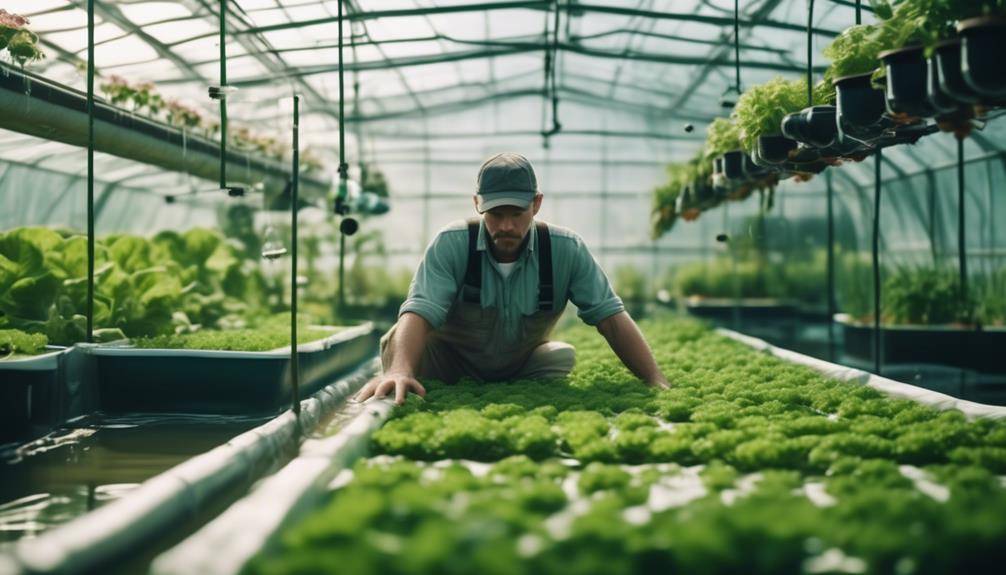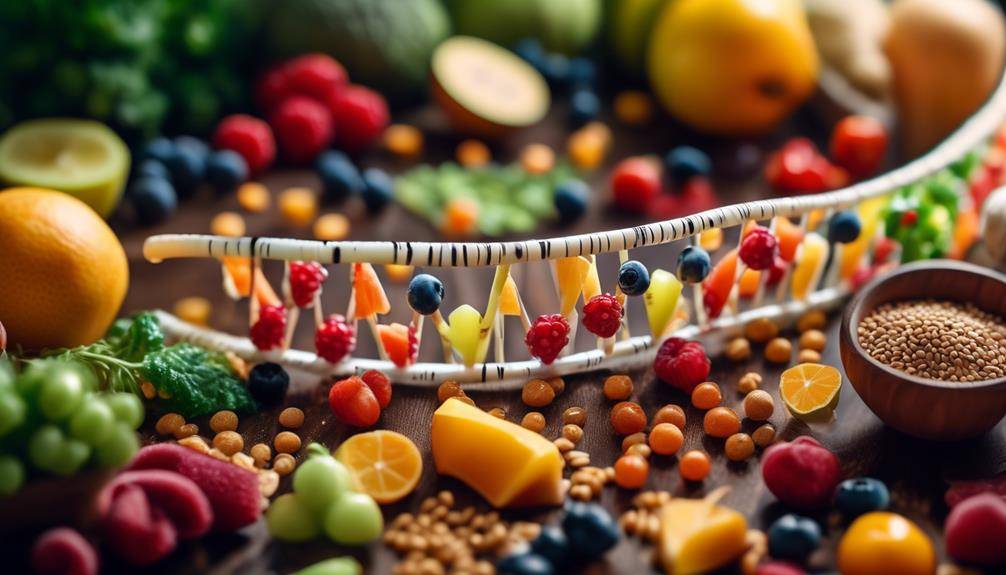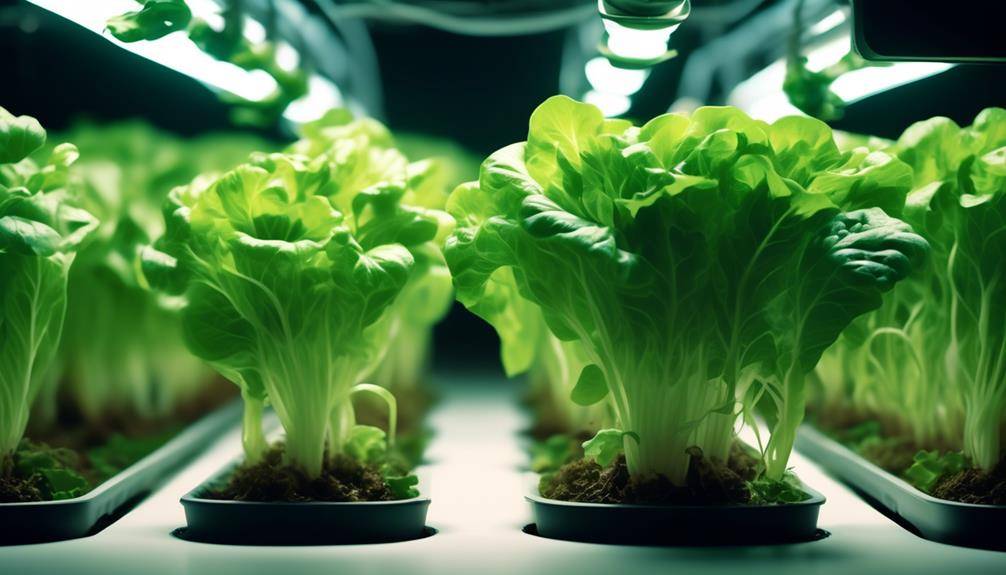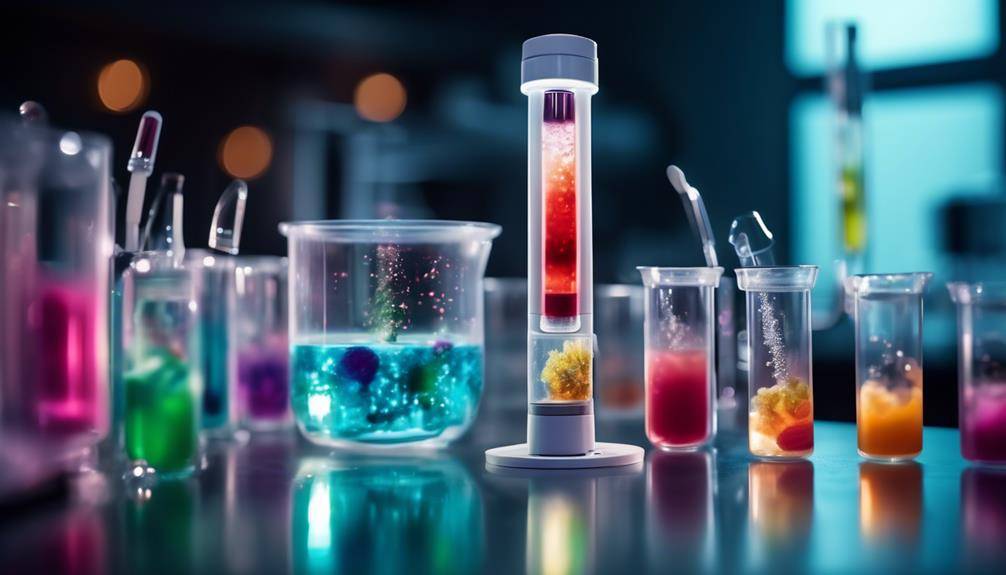How To: Investing In Aquaponics For Farming Business

Imagine a world where your farming business thrives, producing abundant crops and thriving fish, all while using less water and land than traditional farming methods. This is the promise that Aquaponics For Farming Business. Just like a well-oiled machine, aquaponics combines the symbiotic relationship between fish and plants, creating a self-sustaining ecosystem that maximizes efficiency and minimizes waste. But how can you tap into this innovative farming method and invest in aquaponics for your own business? In this discussion, we will uncover the foundations of aquaponics, explore its advantages, and guide you through the process of setting up and managing an aquaponics farm. Get ready to revolutionize your farming practices and reap the rewards of sustainable and profitable agriculture.
Understanding Aquaponics: The Basics
Understanding the basics of aquaponics is essential for anyone interested in starting a farming business using this innovative and sustainable method. Aquaponics combines aquaculture (fish farming) with hydroponics (growing plants in water) to create a symbiotic system where fish waste provides nutrients for plants, while the plants filter the water for the fish. This closed-loop system offers numerous benefits.
One of the primary benefits of aquaponics is its efficiency in water usage. Traditional farming methods consume a significant amount of water, but aquaponics recirculates water, using only a fraction of what conventional farming requires. This makes aquaponics an attractive option for regions with limited water resources or facing drought conditions.
In terms of aquaponic system design, there are various approaches to consider. The most common system types are media bed, nutrient film technique (NFT), and deep water culture (DWC). Media bed systems use a grow bed filled with a medium like gravel or clay pellets, where plants are grown. NFT systems involve flowing a thin film of nutrient-rich water over a sloping channel, allowing plants to take up nutrients. DWC systems involve suspending plants in water, with their roots submerged. Each system has its advantages and considerations, such as the type of crops you wish to grow, available space, and budget.
To maximize the benefits of aquaponics, it is crucial to maintain a proper balance between the fish, plants, and bacteria in the system. Monitoring water quality, ensuring the correct pH and nutrient levels, and managing the fish population are essential tasks for successful aquaponic farming.
Understanding the basics of aquaponics is the first step towards building a successful farming business. By harnessing the benefits of aquaponics and carefully designing your system, you can create a sustainable and efficient method of food production that not only conserves water but also yields fresh, organic produce.
The Advantages of Aquaponics for Farming
Aquaponics offers several advantages for farming businesses. First, it allows for increased crop yields compared to traditional farming methods, thanks to the symbiotic relationship between fish and plants. This means you can produce more food in a smaller space, maximizing your productivity. Second, aquaponics is a sustainable farming method that reduces water consumption and eliminates the need for chemical fertilizers, making it environmentally friendly. Lastly, it is an efficient use of resources, as the water and nutrients are constantly recycled within the system, minimizing waste.
Increased Crop Yields
To maximize your crop yields and achieve greater productivity in your farming business, consider implementing aquaponics, a sustainable and innovative farming method. Aquaponics combines aquaculture and hydroponics, creating a mutually beneficial relationship between fish and plants. This system provides numerous advantages, including increased crop yields. Aquaponics allows for improved crop quality as plants receive a constant supply of nutrients from the fish waste, resulting in healthier and more nutrient-dense produce. Additionally, aquaponics promotes sustainable agriculture by reducing water usage compared to traditional farming methods. The closed-loop system recirculates water, minimizing waste and conserving resources. With aquaponics, you can expect higher crop yields while maintaining a sustainable and environmentally friendly farming operation.
Sustainable Farming Method
By implementing aquaponics, you can not only achieve increased crop yields in your farming business, but also benefit from a sustainable farming method that conserves resources and promotes environmental stewardship. Aquaponics is a type of vertical farming that combines aquaculture and hydroponics, creating a closed-loop system where fish and plants mutually benefit from each other. This method eliminates the need for soil and uses 90% less water compared to traditional farming methods.
Additionally, aquaponics relies on organic farming practices, avoiding the use of synthetic fertilizers, pesticides, and herbicides. This ensures that your crops are free from harmful chemicals, making them healthier and more nutritious. Moreover, this sustainable farming method reduces the carbon footprint of your farm by minimizing water and energy usage, making it an environmentally friendly choice for the future of agriculture.
Efficient Use of Resources
With its efficient use of resources, aquaponics offers numerous advantages for farming businesses. This innovative farming method optimizes resources such as water and space, making it an attractive option for sustainable agriculture. Here are some key advantages of aquaponics:
- Resource Optimization:
- Water Conservation: Aquaponics uses 90% less water compared to traditional soil-based farming. The water is continuously recirculated between the fish tanks and plant beds, reducing wastage and ensuring optimal water utilization.
- Space Efficiency: Aquaponics systems can be set up vertically, maximizing the use of limited space. By growing plants vertically, farmers can produce higher yields in a smaller area, making the most of their resources.
Selecting the Right Aquaponics System for Your Business
When selecting the right aquaponics system for your business, there are several key points to consider. First, you need to carefully evaluate the size of the system that will best suit your needs and available space. Additionally, cost and budget planning are crucial factors, as aquaponics systems can vary significantly in price. Finally, it is important to explore different nutrient management techniques to ensure the optimal growth and health of your plants and fish.
System Size Considerations
To ensure the success of your aquaponics farming business, it is crucial to carefully consider the appropriate system size that aligns with your specific needs and goals. The system scalability and optimal system layout are key factors to take into account when determining the size of your aquaponics system. Here are some considerations to help you make an informed decision:
- Scalability:
- Evaluate your current and future production goals to determine the scale of your aquaponics system.
- Consider the available space and resources to ensure that you can expand the system if needed.
- Optimal system layout:
- Assess the layout of your farm and its impact on the efficiency of your aquaponics system.
- Take into consideration factors such as water flow, nutrient distribution, and ease of maintenance.
Cost and Budget Planning
Considering the crucial factors of system scalability and optimal system layout, the next step in building your aquaponics farming business is to carefully plan and budget for the cost of selecting the right aquaponics system. Conducting a cost analysis and financial planning will help you make informed decisions and allocate your resources wisely. Start by researching different aquaponics systems available in the market and comparing their costs.
Take into account not only the initial investment, but also the long-term operating costs, such as energy, water, and maintenance expenses. Additionally, consider the size and scale of your business, as it will impact the cost of the system. By conducting a thorough cost analysis and financial planning, you can ensure that you select an aquaponics system that aligns with your budget and business goals.
Nutrient Management Techniques
To ensure optimal nutrient management and select the right aquaponics system for your farming business, it is imperative to carefully evaluate various techniques available in the market. Here are two nutrient management techniques to consider:
- Vertical Farming: This technique involves growing plants in vertically stacked layers, using limited space more efficiently. By utilizing vertical space, you can maximize your crop yield and reduce the overall footprint of your farm. Vertical farming is particularly beneficial for aquaponics systems as it allows better nutrient distribution and light exposure.
- Organic Fertilizer: Utilizing organic fertilizers in your aquaponics system ensures the growth of healthy and chemical-free crops. Organic fertilizers, such as compost, fish emulsion, and worm castings, provide essential nutrients to the plants while promoting soil health and biodiversity. Additionally, they reduce the risk of water pollution and contribute to the sustainability of your farming practices.
Choosing the Ideal Fish and Plant Species
When selecting the ideal fish and plant species for your aquaponics farming business, prioritize compatibility and productivity to ensure optimal results. The success of your aquaponics system relies heavily on choosing the right fish and plants that can thrive together and provide mutual benefits.
For ideal fish selection, consider species that are hardy, adaptable, and can tolerate the water conditions in your system. Tilapia, for example, is a popular choice due to its fast growth rate, high tolerance for water temperature fluctuations, and ability to convert feed efficiently into protein. Other suitable options include catfish, trout, and carp. Conduct thorough research on each species, taking into account factors such as their dietary requirements, growth rates, and market demand.
When it comes to plant species selection, opt for those that can efficiently utilize the nutrients provided by the fish waste. Leafy greens like lettuce, spinach, and kale are excellent choices as they have a high nutrient uptake rate and can be harvested multiple times. Herbs such as basil, mint, and parsley also work well in aquaponics systems. Consider the market demand, growth rate, and compatibility with the fish species when making your decision.
Remember that the compatibility between the fish and plants is crucial for the overall success of your aquaponics system. Some fish species prefer cooler water temperatures, while others thrive in warmer conditions. Likewise, certain plants may require specific pH levels or nutrient concentrations to thrive. Ensuring compatibility between the fish and plant species will promote a balanced ecosystem, leading to healthier and more productive yields.
Setting Up Your Aquaponics Farm: Equipment and Infrastructure
To successfully set up your aquaponics farm and ensure optimal productivity, it is essential to have the right equipment and infrastructure in place. The success of your aquaponics system depends on careful equipment selection and proper infrastructure planning. Here are some key considerations to keep in mind:
Equipment Selection:
- Grow Beds: Choose grow beds that are durable, non-toxic, and have good water retention properties. Options include media-based grow beds, nutrient film technique (NFT) systems, and deep water culture (DWC) systems.
- Fish Tanks: Select fish tanks that are suitable for the fish species you intend to raise. Consider factors such as size, material (fiberglass, polyethylene, or concrete), and ease of cleaning and maintenance.
- Pumps and Aeration Systems: Invest in reliable pumps and aeration systems to ensure proper water circulation and oxygenation. This will promote healthy plant growth and fish health.
- Water Filtration: Install a robust filtration system to remove solid waste, excess nutrients, and harmful chemicals from the water. This will help maintain water quality and prevent disease outbreaks.
Infrastructure Planning:
- Greenhouse or Structure: Decide whether you want to set up your aquaponics farm in a greenhouse or an open structure. Greenhouses provide better control over temperature, humidity, and pests, while open structures can be more cost-effective.
- Water Source and Storage: Identify a reliable water source and plan for adequate water storage capacity. Consider rainwater harvesting and water recycling systems to minimize water usage and costs.
- Electrical and Plumbing: Ensure you have sufficient electrical capacity for pumps, lights, and other equipment. Plan for proper plumbing to distribute water efficiently and manage drainage effectively.
Managing and Maintaining Your Aquaponics System
Maintaining optimal conditions and managing the various components of your aquaponics system is crucial for its long-term success. To ensure the smooth operation of your system, implementing effective maintenance techniques and troubleshooting tips is essential.
Regularly monitoring water quality is vital in aquaponics. Test the pH levels, ammonia, nitrite, and nitrate levels weekly using appropriate kits. Adjust the pH as needed to maintain a range between 6.8 and 7.2, which is optimal for both plants and fish. Keep ammonia levels below 1.0 ppm, nitrite levels below 0.5 ppm, and nitrate levels below 40 ppm to prevent harm to fish and maintain plant health.
Maintaining proper water flow is another critical aspect of aquaponics system management. Regularly inspect pipes, fittings, and pumps to ensure there are no leaks or blockages. Clean the filters and remove any debris that may accumulate, as this can affect the water flow and lead to poor system performance.
Regularly inspecting and maintaining the health of your fish is crucial. Monitor their behavior, appetite, and overall appearance. Treat any signs of disease promptly to prevent the spread to other fish. Regularly clean the tanks and remove any uneaten food to maintain water quality and prevent the buildup of harmful bacteria.
In terms of troubleshooting, it is important to identify and address issues promptly. If you notice poor plant growth, check the nutrient levels and adjust accordingly. If fish health deteriorates, test the water quality and make any necessary adjustments. Address any leaks, blockages, or malfunctions immediately to prevent further damage to the system.
Maximizing Profitability in Aquaponics Farming
To maximize profitability in aquaponics farming, it is essential to implement efficient production methods and optimize resource allocation. By maximizing efficiency, you can increase your output and reduce costs, ultimately leading to higher profits. Here are some strategies to help you achieve this:
- Implement automation: Investing in automation can streamline your operations and reduce labor costs. Automated systems can monitor and control water quality, feeding schedules, and harvesting, ensuring optimal conditions for your plants and fish.
- Optimize crop selection: Choose crops that are in high demand and have a quick growth cycle. This will allow you to maximize production and generate more revenue throughout the year. Conduct market research to identify crops with a strong demand and align your production accordingly.
- Develop effective marketing strategies: To maximize profitability, it is crucial to have a strong marketing presence. Utilize social media platforms, create a website, and participate in local farmers’ markets to promote your aquaponics products. Establish partnerships with local restaurants or grocery stores to secure consistent buyers for your produce.
- Implement vertical farming: Vertical farming systems can help maximize space utilization and increase production capacity. By growing plants in vertical towers or shelves, you can grow more crops in a smaller footprint, leading to higher yields and increased profitability.
- Optimize feed conversion ratio: By closely monitoring and adjusting the feed given to your fish, you can optimize their growth and reduce feed costs. This will directly impact your profitability as fish feed is often one of the major expenses in aquaponics farming.
Aquaponics For Farming Business; Frequently Asked Questions
What Are the Potential Challenges or Drawbacks of Investing in Aquaponics for Farming Business?
Investing in aquaponics for your farming business may present challenges and drawbacks. These could include high startup costs, complex system maintenance, and a steep learning curve. However, the potential benefits, such as increased productivity and sustainability, may outweigh these challenges.
How Long Does It Typically Take to See a Return on Investment in an Aquaponics System?
Typically, it takes a few years to see a return on investment in an aquaponics system. The timeline depends on various factors such as initial investment, operational costs, market demand, and efficiency of the system.
Are There Any Government Regulations or Permits Required for Operating an Aquaponics Farm?
To operate an aquaponics farm, you must comply with government regulations and obtain the necessary permits. These regulations ensure the safety and sustainability of your farm and protect the environment and public health.
Can Aquaponics Be Used for Growing Crops That Have Specific Temperature or Environmental Requirements?
Yes, aquaponics can be used for growing crops with specific temperature or environmental requirements. By controlling factors like water temperature, pH levels, and nutrient levels, aquaponics provides an ideal environment for crops to thrive.
What Are Some Common Mistakes or Pitfalls to Avoid When Starting an Aquaponics Farm for the First Time?
When starting an aquaponics farm for the first time, common mistakes and pitfalls to avoid include inadequate planning, insufficient research, poor system design, improper fish and plant selection, and underestimating the costs and time commitment. Avoid these to maximize your aquaponics farm investment and achieve a higher return on investment.
Conclusion
In conclusion, investing in aquaponics for your farming business can offer numerous advantages, such as increased productivity, sustainability, and cost-effectiveness. By selecting the right aquaponics system, choosing suitable fish and plant species, and effectively managing and maintaining the system, you can maximize profitability in this innovative farming method. With the right equipment and infrastructure in place, aquaponics can revolutionize your farming business and provide a lucrative and sustainable source of income.








